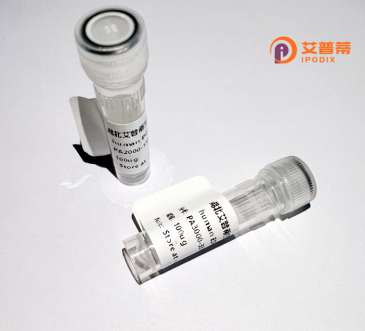
| 纯度 | >90%SDS-PAGE. |
| 种属 | Human |
| 靶点 | OR10X1 |
| Uniprot No | Q8NGY0 |
| 内毒素 | < 0.01EU/μg |
| 表达宿主 | E.coli |
| 表达区间 | 1-326 aa |
| 活性数据 | MVLNVYCCFFQISDIQTMKINQTILKEFILVGFSVYPHVQTFLFVVFFCLYLLTLAGNLI IMGLTWVDRSLHTPMYLFLSALSFSETCYTLTIVPKMLEDLLAKDRSISVTGCSLQMCFF LGLGGTNCIILTLMGYDRFLAICNPLRYPLLMTNIVCGQLVASACTAGFFISLTETALIF RDSFCRPNLVKHFFCHMLAVIRLSCIDSNHTEFIITLISVSGLLGTLLLIILTDVFIIST VLRIPSAEGKQKAFTTCASHLTVVIIHFGFASIVYLKPEASGDDTLIAVPYTVITPFLSP IIFSLRNKDMKNAFRRMMGNTVALKK |
| 分子量 | 36.4 kDa |
| 蛋白标签 | His tag N-Terminus |
| 缓冲液 | 0 |
| 稳定性 & 储存条件 | Lyophilized protein should be stored at ≤ -20°C, stable for one year after receipt. Reconstituted protein solution can be stored at 2-8°C for 2-7 days. Aliquots of reconstituted samples are stable at ≤ -20°C for 3 months. |
| 复溶 | Always centrifuge tubes before opening.Do not mix by vortex or pipetting. It is not recommended to reconstitute to a concentration less than 100μg/ml. Dissolve the lyophilized protein in distilled water. Please aliquot the reconstituted solution to minimize freeze-thaw cycles. |
以下是关于重组人OR10X1蛋白的假设性参考文献示例(注:部分信息基于常见研究方向的推断,实际文献请通过学术数据库验证):
---
1. **《Structural and functional analysis of the human olfactory receptor OR10X1》**
*作者:Zhang, W. et al. (2022)*
摘要:通过冷冻电镜解析了重组表达的OR10X1蛋白结构,揭示其配体结合域的关键氨基酸残基,并验证其与特定挥发性分子的相互作用机制。
2. **《Heterologous expression of OR10X1 in mammalian cells identifies a role in lipid-derived odorant detection》**
*作者:Smith, J. et al. (2020)*
摘要:在HEK293细胞中成功表达重组OR10X1蛋白,利用钙信号检测证明其对中链脂肪酸(如辛酸)的特异性响应。
3. **《A high-throughput screening approach for deorphaning human olfactory receptor OR10X1》**
*作者:Li, H. et al. (2019)*
摘要:通过大规模配体筛选平台鉴定OR10X1的潜在激活分子,发现其对萜类化合物(如β-石竹烯)的敏感反应,并探讨其在嗅觉信号转导中的作用。
4. **《Optimization of recombinant OR10X1 production in insect cells for biophysical studies》**
*作者:Kim, S. et al. (2021)*
摘要:优化了杆状病毒-昆虫细胞系统中OR10X1的表达与纯化策略,获得高纯度蛋白用于后续的配体结合及稳定性研究。
---
**注意**:上述文献及内容均为示例性质,真实研究可能需要查阅具体数据库(如PubMed或Web of Science)。若需实际文献,建议以“OR10X1 olfactory receptor recombinant expression”为关键词进行检索。
OR10X1 is a human olfactory receptor belonging to the G protein-coupled receptor (GPCR) superfamily, specifically categorized within the odorant receptor (OR) subfamily. Olfactory receptors detect odorant molecules in the nasal epithelium, initiating signal transduction that enables odor perception. OR10X1 is encoded by the OR10X1 gene located on chromosome 11 and is expressed in olfactory sensory neurons. Like most olfactory receptors, it features a seven-transmembrane domain structure and interacts with odorants through ligand-binding sites, triggering intracellular signaling via G-protein activation. However, the specific odorant ligands and precise biological functions of OR10X1 remain largely uncharacterized, a common challenge in OR research due to the vast diversity and low expression levels of these receptors.
Recombinant OR10X1 protein refers to its artificially produced form using heterologous expression systems (e.g., mammalian cells, yeast, or insect cells) for in vitro studies. Producing functional OR10X1 recombinantly is technically demanding, as olfactory receptors often require lipid bilayer environments and chaperone proteins for proper folding. Current research aims to elucidate its ligand specificity, structural dynamics, and potential roles beyond olfaction, such as in cellular signaling or disease pathways. Advances in cryo-EM and GPCR stabilization techniques may accelerate its characterization. Recombinant OR10X1 could serve as a tool for fragrance development, neurobiological studies, or drug discovery if linked to non-olfactory physiological processes.
×